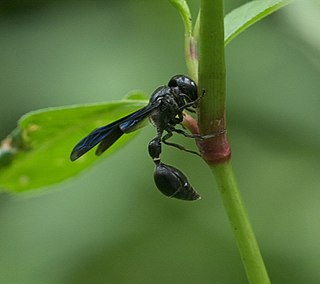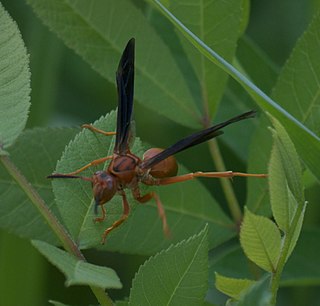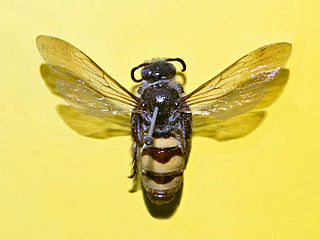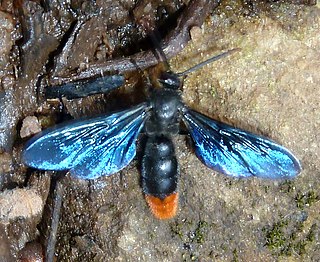
The Scoliidae, the scoliid wasps, are a family of wasps comprising about 560 species worldwide. They tend to be black, often marked with yellow or orange, and their wing tips are distinctively corrugated. Males are more slender and elongated than females, with significantly longer antennae, but the sexual dimorphism is not as apparent as in many of the Tiphiidae and Thynnidae.

Megascolia procer, the giant scoliid wasp, is a solitary wasp in the family Scoliidae found across Asia. It is one of the largest wasps in the world, with a wingspan of 11.6 cm (4.6 in).

Scolia hirta is a species of wasp in the subfamily Scoliinae of the family Scoliidae.

Scolia dubia, also known as the two-spotted scoliid wasp or a blue-winged scoliid wasp, is a species in the family Scoliidae.

Scolia is a genus of scoliid wasps in the subfamily Scoliinae. There are over 200 described species in Scolia.

Campsomeris is a Neotropical genus of the family Scoliidae, also known as the scoliid wasps. They are generally parasites of beetle larvae, most often of Scarabaeidae.

Scolia nobilitata, also known as the noble scoliid wasp, is a species of scoliid wasp in the family Scoliidae.

Zethus spinipes is a species of stinging wasp in the family Vespidae found in the eastern United States.

Polistes bahamensis is a large species of colourful paper wasp in the genus Polistes of the family Vespidae which occurs in the Bahamas, Florida and Louisiana. It is also said to occur in Georgia.

Polistes rubiginosus is one of two species of red paper wasp found in the eastern United States and is noted for the coarser ridges on its propodeum. It is a social wasp in the family Vespidae. Until taxonomic revision by Matthias Buck in 2012, P. rubiginosus was long known under the name P. perplexus. It occurs northernmost from Maryland, Pennsylvania to northern Ohio, south to Florida, and from there west to central Illinois, Kansas, Oklahoma, Texas and Arizona.

Dielis is a New World genus of the family Scoliidae, also known as the scoliid wasps, formerly treated as a subgenus within Campsomeris.

Pygodasis is a New World genus of wasps in the family Scoliidae, formerly treated as a subgenus within Campsomeris.

Xanthocampsomeris is a New World genus of the family Scoliidae, also known as the scoliid wasps, formerly treated as a subgenus within Campsomeris.

Campsomerini is a cosmopolitan tribe of the family Scoliidae. An older, alternative representation of this group is as a subfamily, Campsomerinae.

Scoliini is a cosmopolitan tribe of the family Scoliidae.

Pyrrhoscolia is a genus of scoliid wasps in the subfamily Scoliinae. It is native to the Afrotropics, where they have been recorded in various Afromontane regions. They are external parasitoids of beetle larvae. The wings of all three species are noted for their brilliant lustre.

Dielis plumipes, the feather-legged scoliid wasp, is a species of scoliid wasp in the family Scoliidae.

Dielis pilipes, the hairy-footed scoliid wasp, is a species of scoliid wasp in the family Scoliidae.

Dielis tolteca, the Toltec scoliid wasp, is a species of hymenopteran in the family Scoliidae. It is commonly found on plants in the genus Solidago.

Dielis tejensis is a species of scoliid wasp. It is endemic to Texas.






















